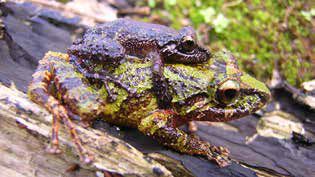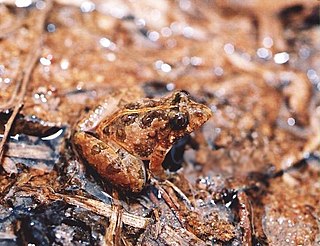
Pseudopaludicola is a genus of leptodactylid frogs from lowland northern and central South America. They are known under the common name dwarf swamp frogs or swamp frogs.
Hyloxalus betancuri is a species of frogs in the family Dendrobatidae. It is endemic to Colombia where it is only known from its type locality in Ituango, Antioquia Department, on the Cordillera Occidental at 1,450 m (4,760 ft) asl. Its natural habitats are sub-Andean forests where it can be found on the ground next to streams. There are no known threats to this species, and the type locality is within the Parque Nacional Natural Paramillo.
Hyloxalus borjai is a species of frog in the family Dendrobatidae. It is endemic to Colombia and only known from its type locality, Amalfi, Antioquia, on the Cordillera Central at 1,575 m (5,167 ft) asl. Its natural habitats are sub-Andean forests. Very little is known about this species.
Hyloxalus breviquartus is a species of frog in the family Dendrobatidae. It is found in the northern part of Cordillera Occidental in Antioquia, Colombia, and in Carchi Province in northwestern Ecuador. Colombian distribution may be wider. Its natural habitats are montane forests next to streams and very humid premontane forests. It is threatened by habitat loss, although it occurs in the Las Orquídeas National Natural Park, its type locality.
Hyloxalus excisus is a species of frog in the family Dendrobatidae. It is endemic to Colombia. It is only known from its type locality near Medellín, Antioquia Department, on the Cordillera Central.
Hyloxalus pinguis is a species of frog in the family Dendrobatidae. It is endemic to Colombia where it is only known from its type locality, on the Cordillera Central, the Cauca Department. Its natural habitats are cloud forests. The type locality is in the Puracé National Natural Park.

Rheobates pseudopalmatus is a species of frog in the family Aromobatidae. It is endemic to the Antioquia Department in Colombia where it is only known from the region of its type locality, Amalfi. It might be the same species as Rheobates palmatus. The ecology and habits of this species are unknown, but it is presumed to require streams for its larval development.
Leucostethus ramirezi is a species of frog in the family Dendrobatidae that is endemic to Colombia. It is only known from the region of its type locality, Urrao in the Antioquia Department. Its natural habitat is sub-Andean forest.
Leucostethus yaguara is a species of frog in the family Dendrobatidae. It is endemic to Colombia where it is only known from its type locality, Ituango, on the Cordillera Occidental in the northern Antioquia Department. It might be conspecific with Colostethus fraterdanieli. Its natural habitats are cloud forests where it can be found in leaf-litter near streams.
Adelophryne adiastola is a species of frog in the family Eleutherodactylidae. It is found in the Amazon Basin in Colombia, Ecuador, Peru, and western Brazil.
Pristimantis phragmipleuron is a species of frog in the family Strabomantidae. It is endemic to Colombia where it is known only from its type locality, Pan de Azúcar, Cordillera Central, in the Antioquia Department. Its natural habitat is tropical cloud forest. It is a rare species threatened by habitat loss; the habitat at the type locality has badly suffered from human settlement and the collection of firewood.
Pristimantis repens, known commonly as the Galeras robber frog, is a species of frog in the family Strabomantidae. It is endemic to the Colombian Massif in the Nariño Department, Colombia. The specific name repens is Latin for creeping or crawling, inferred to be its mode of locomotion based on its short limbs.

Pristimantis riveroi is a species of frog in the family Strabomantidae. It is endemic to Venezuela and only known from the region of the type locality in the Serranía del Litoral in the state of Aragua. The specific name riveroi honours Juan A. Rivero, a Puerto Rican herpetologist. Accordingly, common name Rivero's ground frog has been proposed for it.

Pristimantis scolodiscus is a species of frog in the family Strabomantidae. It is found on the Pacific slopes of the Andes in northern Ecuador and in the Colombian Massif in the Nariño Department in the adjacent south-western Colombia. Its elevational range is 1,200–1,780 m (3,940–5,840 ft) above sea level.
Pseudopaludicola llanera is a species of frog in the family Leptodactylidae. It is found in the Llanos in the Amazon and Orinoco basins in northeastern Colombia and northern Venezuela. It is mostly found at altitudes below 800 m (2,600 ft), but there is one record from Cerro Corocoro (Venezuela) at 1,220 m (4,000 ft) above sea level. The specific name llanera is Spanish word for a female inhabitant of the Llanos.

Pseudopaludicola saltica, also known as the Chupada swamp frog or long-legged swamp froglet , is a species of frog in the family Leptodactylidae. It is endemic to south-central Brazil.

Hyloxalus is a genus of poison dart frogs, family Dendrobatidae. The genus is distributed in Central and South America, from Panama south to Peru, along with Venezuela, Colombia, and Ecuador. They also inhabit the eastern foothills of the Andes in Bolivia to Venezuela, east to the upper Amazon Basin.
Marco Antonio Serna Díaz was a Colombian herpetologist, ornithologist, and naturalist.

Pseudopaludicola falcipes is a species of frog in the family Leptodactylidae. It is found in the Pampas of northeastern Argentina, Uruguay, and southern Brazil.

The Leiuperinae are a subfamily of frogs in the family Leptodactylidae. Over 90 species are in five genera. The distribution of this subfamily is from southern Mexico to the Central America and much of South America.







